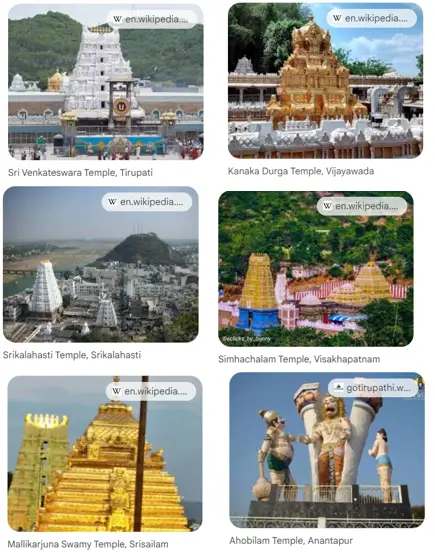Plan a trip to temples in Andhra Pradesh and Telangana
South India is a land rich in culture and heritage, and this is reflected in the numerous temples that dot the states. Here are 10 of the most famous temples in Andhra Pradesh, Telangana for your trip to temples:
- Sri Venkateswara Temple, Tirupati: This is one of the most famous temples in all of India, dedicated to Lord Venkateswara, an incarnation of Vishnu. The temple is located on the Seven Hills of Tirumala and attracts millions of pilgrims every year, this temple is a must in your trip to temples.
- Kanaka Durga Temple, Vijayawada: This temple is dedicated to Goddess Durga and is situated on the Indrakeeladri hill overlooking the Krishna River. The temple is a major pilgrimage center for Hindus in South India.
- Srikalahasti Temple, Srikalahasti: This temple is one of the five sacred Shivastalams in Andhra Pradesh and is dedicated to Lord Shiva. The temple is known for its intricate carvings and its unique architecture.
- Simhachalam Temple, Visakhapatnam: This temple is dedicated to Lord Vishnu in his Varaha Narasimha avatar. The temple is located on a hilltop overlooking the Visakhapatnam coast and offers stunning views of the Bay of Bengal.
- Mallikarjuna Swamy Temple, Srisailam: This temple is another one of the five sacred Shivastalams in Andhra Pradesh and is located in the Nallamala Hills. The temple is dedicated to Lord Shiva and Parvati.
- Ahobilam Temple, Anantapur: This temple complex is dedicated to Lord Narasimha and is located in the Nallamala Hills. There are nine Narasimha temples in the complex, each representing a different aspect of the god.
- Yaganti Temple, Kurnool: This temple is dedicated to Lord Shiva and is known for its unique rock formations. The temple complex consists of three caves, each with its own shrine.
- Lepakshi Temple, Anantapur: This temple complex is known for its architectural beauty and its hanging pillar. The temple is dedicated to Lord Shiva, Vishnu, and Veerabhadra.
- Thousand Pillar Temple, Warangal: This temple is a UNESCO World Heritage Site and is known for its intricate carvings and its 1,000 pillars. The temple is dedicated to Lord Shiva.
- Ramappa Temple, Warangal: This temple is another UNESCO World Heritage Site and is known for its unique architecture. The temple is dedicated to Lord Shiva and is built in the Kakatiya style of architecture.

The predominant style of architecture seen in South Indian temples is called Dravidian architecture.
Here’s a quick rundown of some key features of Dravidian architecture for your trip to temples:
- Vimana: Instead of the tall, curving towers (shikharas) seen in North Indian temples, South Indian temples have a shorter pyramidal structure called a vimana on top of the sanctuary.
- Horizontal Emphasis: The vimana creates a more horizontal emphasis compared to the verticality of North Indian temple towers.
- Multi-Storied Vimanas: The vimana itself is often multi-storied, with each story adorned with intricate carvings and sculptures.
- Gopurams: Elaborate gateways called gopurams are placed at the entrance of the temple complex. These gopurams can be monumental and covered in sculptures of deities and mythological scenes.
- Mandapas: pillared halls or porches (mandapas) are another characteristic feature, providing space for gatherings and rituals.
your trip to Temples in India will make you understand how they have played a multifaceted role in people’s lives, extending far beyond religious worship. Here’s a glimpse into how they’ve benefited communities:
- Spiritual & Religious Center: Primarily, temples serve as a sacred space for prayer, offerings, and connecting with the divine. They provide a place for religious ceremonies, festivals, and seeking solace during difficult times, you may experience spiritual energy with your trip to temples.
- Social Hub: Temples fostered a strong sense of community. People would gather for festivals, weddings, and social events, creating a strong social network and promoting community bonding.
- Education & Learning: Many temples housed educational institutions or functioned as learning centers. Knowledge of scriptures, languages, and even arts like music and dance were imparted within the temple complex.
- Charity & Public Service: Temples often provided food and shelter for the poor and needy. Additionally, some temples might have run schools or hospitals, offering social services to the community.
- Preservation of Culture & Arts: Temple architecture, intricate carvings, sculptures, and paintings showcase a rich artistic heritage. with your trip to temples you can learn about Traditional art forms like dance and music were often performed within the temple premises, helping preserve cultural traditions.
- Economic Activity: Temples generated economic activity by employing people for construction, maintenance, and performing rituals. They might have also owned farmlands or businesses, contributing to the local economy.
- Historical Significance: Many temples are ancient structures that stand as testaments to bygone eras. in your trip to temples you can Study their architecture, inscriptions, and artwork provides valuable insights into history and the lives of past civilizations.
